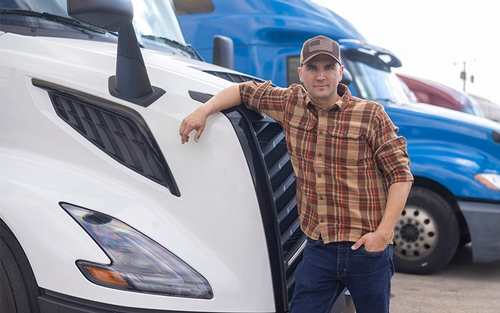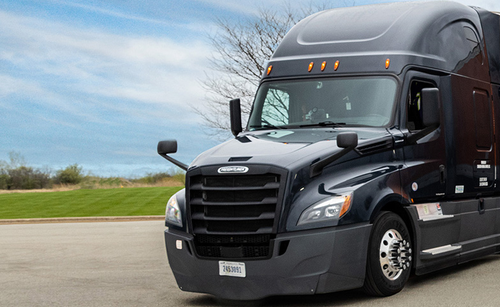How to get apportioned plates: 5 tips you need to know
September 16, 2025

Estimated reading time: 3 minutes
Getting the right license plates on your semi-truck is an important part of running your own trucking business.
In this guide, we’ll cover the basics on how to get apportioned plates as an interstate owner-operator, including what to expect during the application process.
This article is not intended to, and does not, provide legal, tax, or business advice, nor is it intended to be an exhaustive list of all requirements that an owner-operator must follow in connection with getting apportioned plates. We recommend that you engage with your local state and applicable professional consultants to ensure that you are taking advantage of the best opportunities for your business.
What is an apportioned plate?
An apportioned plate is the type of license plate you receive when you register under the International Registration Plan (IRP). Registered motor carriers with apportioned plates can travel through all 48 contiguous U.S. states, District of Columbia (DC) and all Canadian provinces.
What is the International Registration Plan (IRP)?
If you’re an owner-operator who hauls loads across state lines, your truck may need to be registered through the International Registration Plan (IRP).
The IRP is an agreement among states of the U.S., DC and Canada that allows owner-operators to travel between states and provinces without registering their truck in each place.
Owner-operators who run under Schneider’s authority, for example, have the option to register their truck under Schneider’s Indiana IRP account. They can also choose to register on their own.
How to get apportioned plates in 5 steps
1. Figure out if you qualify for IRP registration.
Not every type of truck that travels across state lines needs to be registered through the IRP.
To qualify, a commercial vehicle must meet at least one of the following requirements:
- Have two axles and a gross vehicle weight or registered gross weight of over 26,000 pounds.
- Have three or more axles, regardless of weight.
- Exceeds a gross weight of 26,000 pounds when combined with a trailer.
For trucks and combination vehicles with a registered gross vehicle weight of 26,000 pounds or less, IRP registration is available but not required.
2. Find your local IRP office.
To get apportioned plates under the IRP, you must register with a base jurisdiction. Visit the IRP jurisdiction directory and search the name of your state or province for specific contact information.
Your IRP jurisdiction office should provide you with Schedule A/E and Schedule B forms to complete. These are the IRP forms required for opening new accounts.
3. Gather the necessary documentation.
Each IRP jurisdiction has its own requirements for applying for apportioned plates, so it’s a good idea to check with your local IRP office to understand what’s needed.
Depending on the jurisdiction, you may be required to provide proof of various items as part of the application process. Requested items could include:
- Proof of established place of business or residency in the state (phone bill, utility bill, driver’s license, title, tax return, etc.).
- Verification of valid USDOT/MC number.
- Copy of Heavy Vehicle Use Tax (HVUT) receipt.
- Evidence of International Fuel Tax Agreement (IFTA) license or proof of who is responsible for filing IFTA returns for your business.
- Copy of driver’s license.
- Confirmation of Unified Carrier Registration (UCR), if applicable.
- Proof of truck insurance.
- Evidence of truck ownership or lease agreement.
If you don’t already have an IFTA license, some jurisdictions allow you to apply for one along with your IRP application.
4. Apply for apportioned plates.
Once you’ve gathered all the other necessary documentation, you should have what you need to start filling out your Schedule A/E and Schedule B forms. These forms may look different from state to state, but most forms include the following:
- Federal Employee ID/TIN: Enter the number issued to your business by the Internal Revenue Service (IRS).
- Vehicle identification number (VIN): Listed on your truck’s Manufacturer’s Certificate of Origin or title.
- Unladen weight: The empty weight of your truck.
- Gross combined weight rating (GCWR): The maximum loaded weight of your semi-tractor and trailer combined, as specified by the tractor manufacturer. This is usually listed on your truck’s VIN plate.
- Axles: The number of axles on your tractor alone. A standard truck tractor has three axles.
- Factory price: The manufacturer's list price of the fully equipped vehicle when new.
- Actual miles traveled: How many miles you traveled through each jurisdiction during the registration period.
5. Submit your application.
Your local IRP office will provide you with instructions for how to submit your application. Most states give you the option to send your completed IRP application and the required documents online, by mail or through a third-party agent.
How long do apportioned plates take to get?
The time it takes to receive apportioned plates after submitting your application varies by jurisdiction. To get an accurate estimate, check with your local IRP office once your application is complete.



